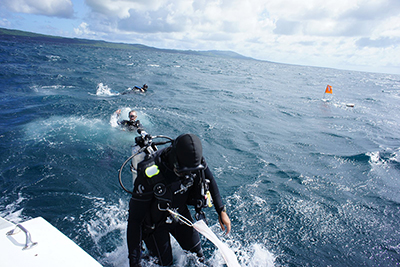- ABOUT US
- PROGRAM AREAS
- CONSERVATION APPROACH
- EDUCATION
- MULTIMEDIA
Ridge-to-reef conservation and management in the Big Island and Guam:Scientists worked to address land-based issues that impact coral reefs in west Hawaii and Manell-Geus in Guam, two of NOAA's Habitat Blueprint focus areas. Ridge-to-reef conservation efforts underway include the creation of rain gardens, the development of watershed restoration techniques, the removal of invasive species, increased community engagement, and much more.
The listing of 20 new coral species as threatened to the Endangered Species Act: This year 20 additional coral species were listed as threatened to the Endangered Species Act, bringing the total to 22 species. Seven of those species are in the Caribbean, while the remaining 15 are in the Pacific.
Monitoring the condition of corals and reef fish at nearly 1,600 sites in the Atlantic, Pacific territories, and U.S. Caribbean: Divers surveyed coral reefs and reef fish communities at nearly 1,600 sites in Puerto Rico, Florida, Guam, the Northern Mariana Islands, and elsewhere in the Pacific. The data collected will help us monitor and understand the condition of corals and reef fish in an ever-changing environment.
Coral Reef Conservation 2014 - A Year in Review

This year, the NOAA Coral Reef Conservation Program together with its many partners made some important strides forward in conserving the nation's coral reefs and advancing the science needed to manage these valuable resources.
From monitoring corals and reef fish at nearly 1,600 sites across the Atlantic, U.S. Caribbean and Pacific territories to supporting the successful listing of 20 new coral species to the Endangered Species Act, 2014 was a busy year for NOAA scientists.
2014's Biggest Moments for Corals
In case you missed it, here's a recap of some of 2014's biggest moments for coral reefs.
There's More
This year also saw the launch of an agreement between NOAA and the U.S. Agency for International Development (USAID) in Asia and the Pacific Islands. Together NOAA and USAID will address pressing ocean issues, including: combatting illegal fishing practices, improving marine protected area management, and training coastal managers. The New Year holds many exciting prospects for this agreement.
Coral scientists continued to make gains in mitigating the impacts of the three primary threats to corals-climate change, fishing, and pollution-through hundreds of projects supported by the Coral Reef Conservation Program. All of these science and conservation successes would not have been possible without key partnerships between the federal government, state and territory agencies, NGOs, academic institutions, and many others.
Plans for the New Year
As 2015 quickly approaches, we in the NOAA Coral Reef Conservation Program look forward to advancing coral reef science and supporting coral reef managers across nation. We will also continue to work closely with local communities to create awareness and build partnerships to meet conservation goals.
To learn more about the Coral Reef Conservation Program and what you can do to protect coral reefs at http://coralreef.noaa.gov/. Please like us on Facebook.
All the best in the New Year,
Jennifer Koss, Acting Program Manager
NOAA Coral Reef Conservation Program
About Us

The NOAA Coral Reef Conservation Program was established in 2000 by the Coral Reef Conservation Act. Headquartered in Silver Spring, Maryland, the program is part of NOAA's Office for Coastal Management.

The Coral Reef Information System (CoRIS) is the program's information portal that provides access to NOAA coral reef data and products.
Work With US
U.S. Coral Reef Task Force
Funding Opportunities
Employment
Fellowship Program
Contracting Assistance
Graphic Identifier
Featured Stories Archive

Access the archive of featured stories here...
Feedback
Thank you for visiting NOAA’s Coral Reef Conservation Program online. Please take our website satisfaction survey. We welcome your ideas, comments, and feedback. Questions? Email coralreef@noaa.gov.
Stay Connected
Contact Us
NOAA’s Coral Reef Conservation Program
SSMC4, 10th Floor
1305 East West Highway
Silver Spring, MD 20910
coralreef@noaa.gov
